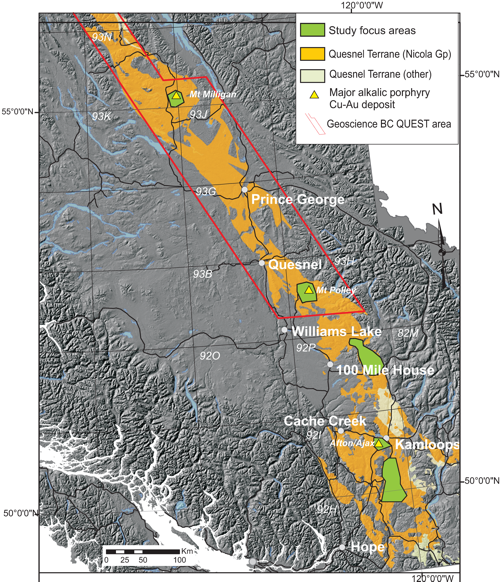Summary
The Triassic Nicola Group and its northern continuation the Takla Group compose most of the Quesnel oceanic island arc terrane, and host the majority of the known alkalic porphyry Cu-Au deposits in British Columbia. Despite their importance as metallotect, the Triassic arc sequences had not extensively been studied in the context of regional metallogeny.
This two year project investigated along strike variations in the physical volcanology, geochemistry and related changes in physical properties of the Nicola Group and parts of the Takla Group. The goals were to identify characteristics indicative for proximity of known porphyry ore deposits and tectonomagmatic processes that lead to porphyry ore formation.
The study concentrated on five key areas within the Geoscience BC Quest geophysical surveys and its southern continuation. These are the areas around the Mount Milligan, Mount Polley and Afton/Ajax alkalic porphyry Cu-Au deposits, as well as two reasonably exposed areas within the Nicola arc without known alkalic porphyry deposits. The latter included the Canim Lake area and exposures 50-100 km south of Kamloops.
Major and trace element whole rock geochemical data was obtained, backed up by limited microanalysis of mineral phases and geochronology (Fossils, U/Pb) where necessary and possible to clarify stratigraphic relationships. The project also routinely analyzed the samples by portable XRF to establish its use for field based large scale geochemical vectoring to mineralization.
Physical rock properties such as magnetic susceptibility, density and electrical conductivity were also measured and related to petrographic observations and chemical variations. The rock property data provide the critical link between the geology of the Quesnel arc and high-quality airborne geophysical data from the QUEST project, and enhance the application of the geophysical inversion codes to map the geology under cover and consequently allow for an improved understanding of the geology from the geophysics.
Field based observations and standard petrographical and geochemical techniques provide prospectivity indices. This includes fingerprinting regionally significant changes in lithogeochemistry which reflects magmatic and/or hydrothermal processes related to alkalic porphyry ore formation.
